You’ll find opals among the most challenging gemstones because they’re composed of delicate silica spheres with a low Mohs hardness of 5-6.5, making them extremely prone to chipping and cracking. They’re incredibly sensitive to temperature fluctuations and humidity changes, which can cause thermal shock and crazing during cutting. Their water content creates additional vulnerabilities, and you’ll need specialized tools and controlled environments to work with them successfully without damaging their precious play-of-color.
Understanding Opal’s Unique Internal Structure and Formation
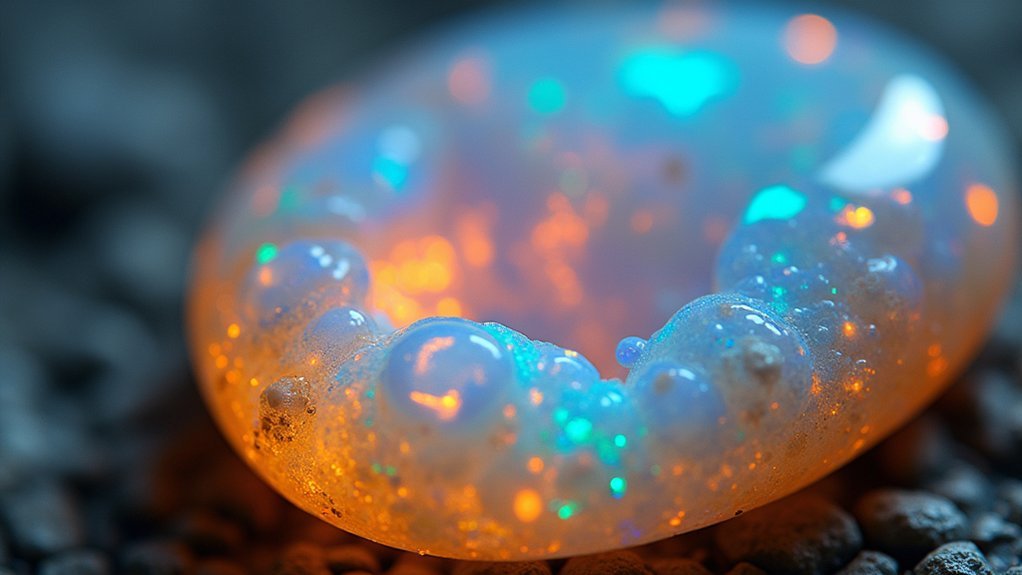
Unlike most gemstones that form through crystallization, opals develop from silica gel that seeps into cracks within sedimentary rocks, where gradual evaporation transforms the liquid into solid opal.
You’ll find that an opal’s enchanting beauty stems from its distinctive internal structure composed of microscopic silica spheres arranged in orderly patterns. These spheres act like tiny prisms, diffracting light to create the mesmerizing play-of-color that makes opals so sought-after.
However, this same structure creates challenges you won’t encounter with other gems. The water content trapped within these silica spheres makes opals vulnerable to environmental changes.
When humidity or temperature fluctuates rapidly, the internal structure expands and contracts unevenly, potentially causing the dreaded “crazing” effect that ruins the stone’s appearance and value.
Why Opal’s Low Hardness Rating Creates Cutting Challenges
While diamonds boast a perfect 10 on the Mohs hardness scale, opals register only between 5 and 6.5, making them considerably more vulnerable during the cutting process.
Opals’ softness on the Mohs scale creates significant vulnerabilities that demand specialized cutting techniques unlike harder gemstones.
This low hardness rating means you’ll encounter significant challenges when working with these gems. The opal’s softness makes it prone to chipping and cracking under standard cutting techniques that work fine for harder stones. You’ll need specialized tools and methods to handle their fragility properly.
The delicate silica sphere structure can create uneven surfaces if you’re not careful, directly impacting the gem’s value. Additionally, you must maintain stable temperatures throughout cutting, as rapid changes can cause devastating crazing.
This complexity makes opal cutting far more time-consuming and demanding than working with traditional gemstones.
The Science Behind Opal’s Fragile Silica Sphere Composition
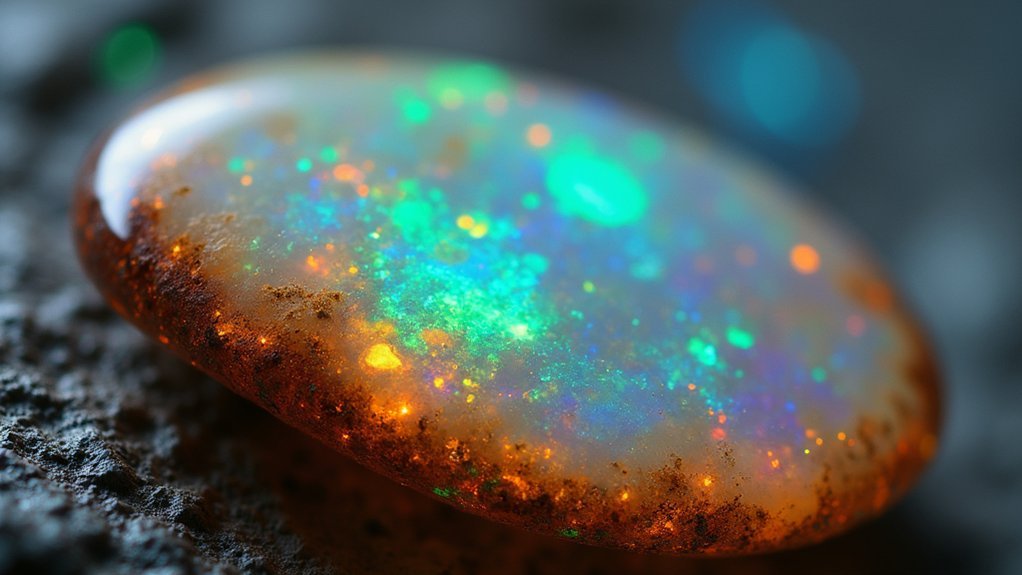
To understand why opals prove so challenging to work with, you need to examine their unique internal architecture. Unlike other gemstones with tightly bonded crystal structures, opals consist of silica spheres arranged in regular patterns.
While this arrangement creates their stunning play-of-color through light diffraction, it’s also their greatest weakness.
The silica spheres aren’t firmly connected, making opals inherently fragile and unstable. This loose bonding means even minor stress can trigger cracking throughout the stone.
Here’s what makes opal composition so problematic:
- Silica spheres lack strong molecular bonds – leaving gaps that compromise structural integrity
- Temperature changes cause expansion – creating internal pressure that splits the stone
- Humidity fluctuations destabilize the structure – leading to devastating crazing patterns
- Mechanical stress easily propagates – turning small impacts into major fractures
Temperature and Humidity Sensitivity During the Cutting Process
These structural vulnerabilities become magnified the moment you begin cutting an opal. You’re dealing with a gem that’s extraordinarily sensitive to temperature fluctuations, requiring constant vigilance throughout the cutting process.
Even minor temperature changes can cause thermal shock, resulting in cracks or crazing that’ll ruin your stone. You’ll need to maintain stable humidity levels too, as low humidity causes rapid moisture evaporation within the opal, compromising its integrity.
The ideal cutting environment demands controlled conditions to prevent visible damage. You can’t rush this process – gradual temperature adjustments are essential to avoid stressing the opal’s delicate structure.
Given opal’s low Mohs hardness rating of 5 to 6.5, experienced cutters monitor environmental conditions closely, knowing that success depends on patience and precision.
Preventing Crazing and Stress Fractures While Shaping
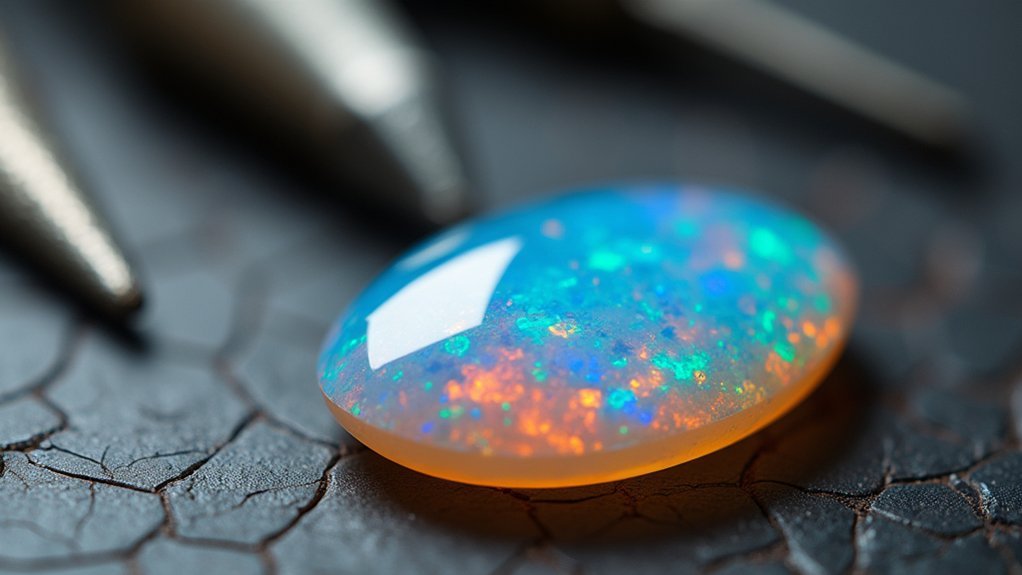
Since crazing represents the most common failure when shaping opals, you’ll want to implement specific preventive measures before making your first cut.
These delicate gems demand respect and careful handling to preserve their stunning beauty.
To protect your precious opals from stress fractures during shaping:
- Maintain stable temperatures – Never expose your opal to extreme heat or cold that could shatter your dreams along with the stone.
- Use gentle cutting techniques – Remember, opals rate only 5-6.5 on the Mohs scale, making aggressive methods devastating.
- Apply proper cooling methods – Water or oil during cutting dissipates heat that could destroy hours of meticulous work.
- Inspect regularly for cracks – Catching internal stress early prevents heartbreaking failures during final stages.
Essential Tools and Equipment for Safe Opal Cutting
While successful opal cutting depends heavily on technique, you’ll discover that having the right tools makes the difference between stunning results and costly disasters.
A high-quality diamond blade saw is your foundation for cutting opals, delivering the precision needed to avoid damaging these fragile stones. You’ll need a reliable water cooling system to prevent overheating, which causes cracks and crazing in temperature-sensitive opals.
Diamond blade saws provide the precision essential for cutting delicate opals without causing damage, while water cooling prevents temperature-related cracking.
Invest in a rotary tool with diamond bits for detailed shaping and polishing work.
Don’t overlook safety equipment—safety goggles and dust masks protect you from silica dust and debris.
Finally, make sure you’ve got a sturdy workbench with a stable surface to securely hold your opal, preventing movement that leads to uneven cuts and breakage.
Orientation Techniques to Maximize Play-of-Color Display
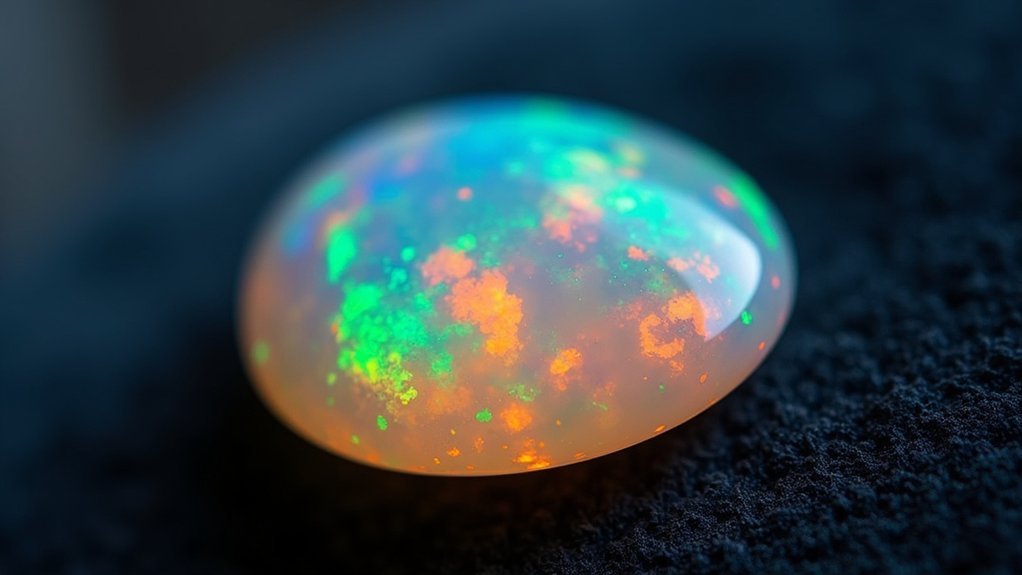
When you hold an opal up to the light and rotate it slowly, you’re witnessing one of nature’s most enchanting optical displays—but achieving peak brilliance requires strategic orientation during the cutting process.
Understanding orientation techniques becomes essential when you’re working with opals. The internal silica structure determines how light diffracts through the stone, making your cutting decisions significant for maximizing play-of-color.
Here’s what you’ll need to master:
- Rotate continuously while observing under light sources to reveal hidden color flashes that’ll take your breath away.
- Position for ideal angles where light strikes the stone’s surface most effectively.
- Create dome shapes that increase light-exposed surface area for stunning vibrancy.
- Experiment with multiple orientations during cutting to achieve perfect color-brilliance balance.
Your patience during this process determines whether you’ll create mediocre stones or breathtaking masterpieces.
Managing Different Opal Types: Solid, Doublet, and Triplet Variations
Solid opals represent the premium category—pure opal material displaying natural play-of-color without enhancement.
You’ll find these gems offer the highest value but require careful handling due to their 5-6.5 Mohs hardness rating.
Doublets feature opal layers fused with backing material, creating enhanced color stability at reduced costs.
You’re working with composite structures that demand gentler treatment during fabrication.
Triplets incorporate three layers: opal, protective clear coating, and base material.
While they provide extra durability and visual impact, you must avoid water exposure and harsh cleaning methods.
Each type requires distinct maintenance protocols.
You can’t treat doublets and triplets like solid opals—their composite nature makes them vulnerable to separation and moisture damage.
Common Cutting Mistakes That Lead to Stone Damage
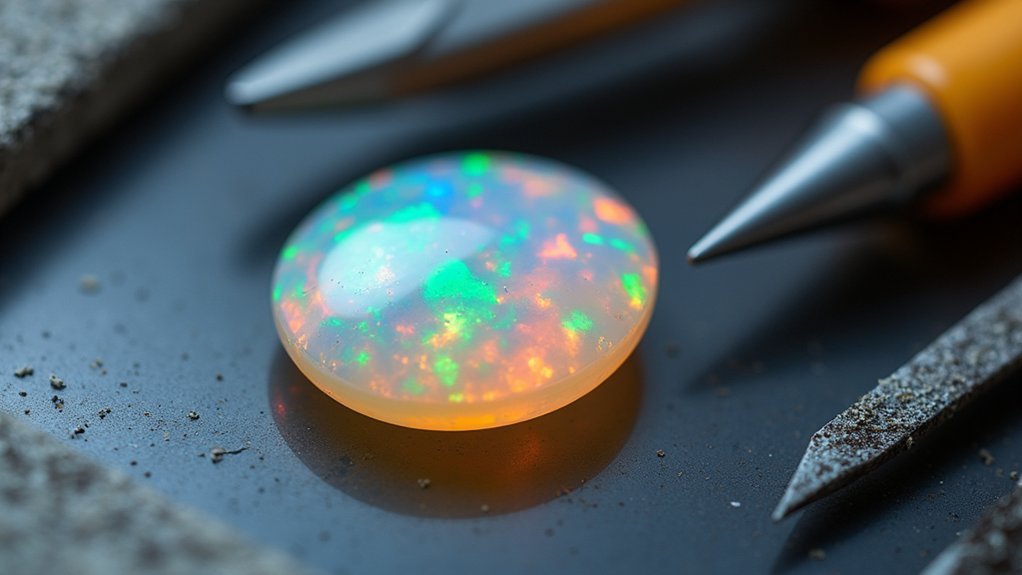
Because opal’s delicate silica structure makes it exceptionally vulnerable to damage, you’ll need to avoid several critical cutting errors that can destroy these precious gems.
When cutting opals, these mistakes can ruin your stone:
- Creating excessive heat – High temperatures cause devastating thermal shock that fractures the delicate silica layers instantly.
- Cutting too thin – Removing too much material compromises structural integrity, making your opal fragile and prone to breaking during setting.
- Ignoring play-of-color orientation – Poor positioning destroys the stone’s natural beauty and dramatically reduces its value.
- Using high-vibration machinery – Powerful vibrations crack the layered composition, creating irreparable damage.
You must work slowly with minimal heat and vibration.
Professional Storage and Handling Protocols for Opal Rough
Since you’ve successfully cut your opal rough without damaging its delicate structure, you’ll now face the equally critical challenge of proper storage and handling.
You must maintain stable temperature and humidity levels to prevent crazing and cracking from environmental fluctuations. Always wear gloves during handling to avoid transferring skin oils and moisture that compromise the stone’s integrity and appearance.
Wrap your opal rough in soft, non-abrasive materials for protection during storage and transport. Keep these gems separated from harder stones to prevent accidental scratching or chipping.
Regular inspections are essential—you’ll want to catch any damage or appearance changes early before deterioration progresses. These protocols guarantee your opal rough maintains its quality and value throughout storage.
Frequently Asked Questions
What Is so Special About Opal?
You’ll find opals enchanting because they’re the only gems displaying “play-of-color” – microscopic silica spheres bend light into rainbow flashes. They’re also surprisingly soft and fragile, making them challenging to work with.
Which Zodiac Should Not Wear Opal?
You shouldn’t wear opal if you’re any zodiac sign except Libra, according to traditional superstitions. Non-October births supposedly face bad luck, though many people today ignore these outdated beliefs.
How Is Opal Different From Other Gems?
You’ll find opals differ from other gems because they’re amorphous rather than crystalline, contain water that causes cracking, display unique play-of-color, and they’re softer with lower hardness ratings.
What Does It Mean if Someone Gives You an Opal?
If someone gives you an opal, they’re offering hope, happiness, and protection. You’ll receive a gem symbolizing deep emotional connection and creativity, though some believe it brings luck only if you’re born in October.
In Summary
You’ll find that mastering opal cutting demands patience, precision, and respect for the gem’s delicate nature. Don’t rush the process—take time to understand each stone’s unique characteristics before you begin. You’re working with one of nature’s most complex gems, so embrace the challenge. With proper techniques, tools, and handling protocols, you’ll transform fragile rough into stunning finished stones that showcase opal’s mesmerizing play-of-color while maintaining structural integrity.

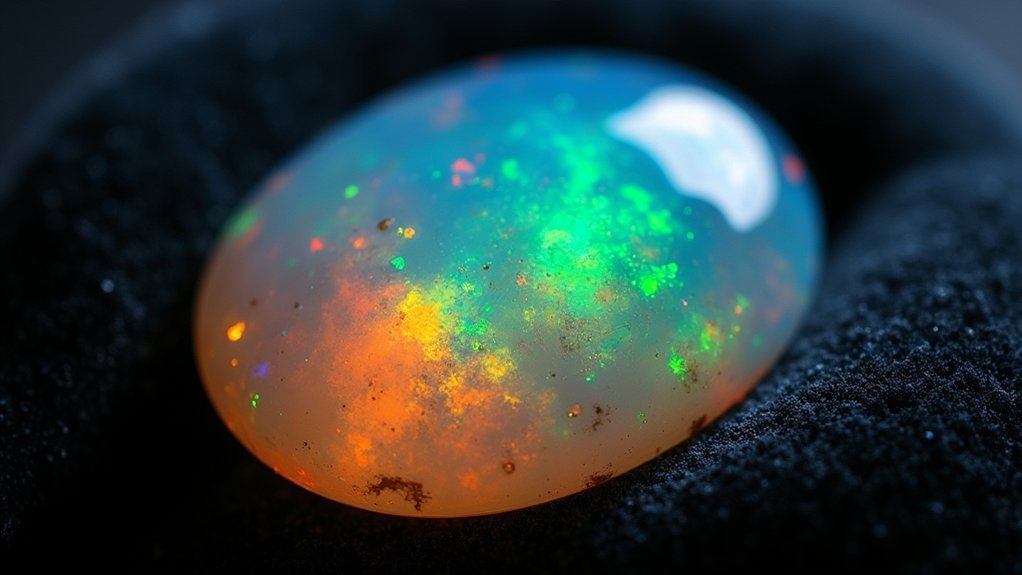
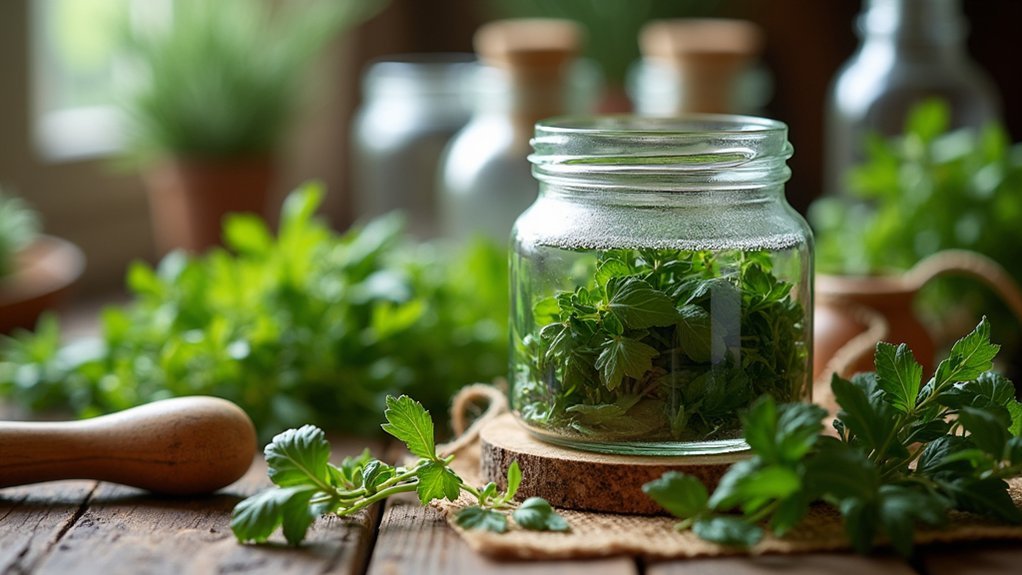
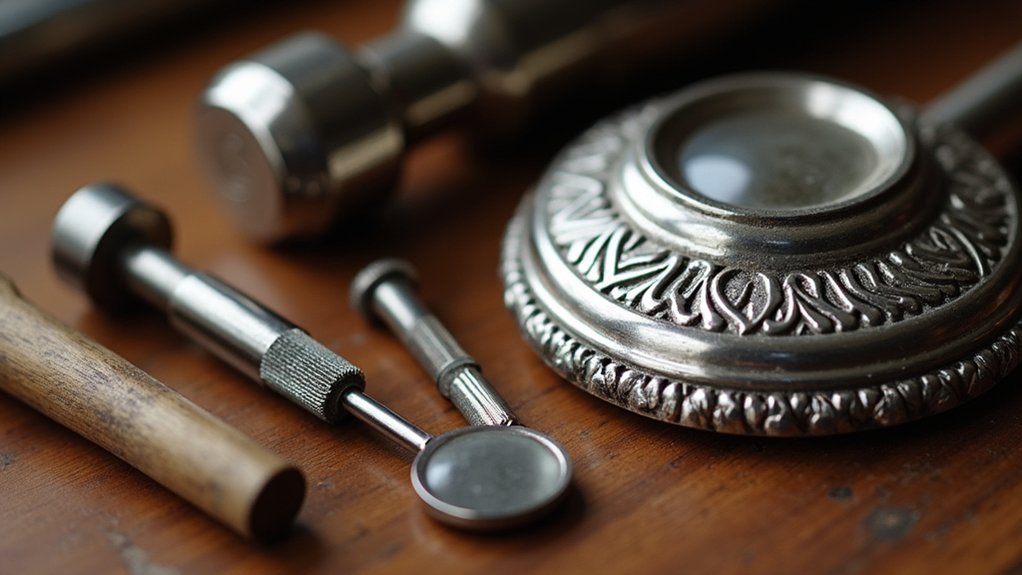
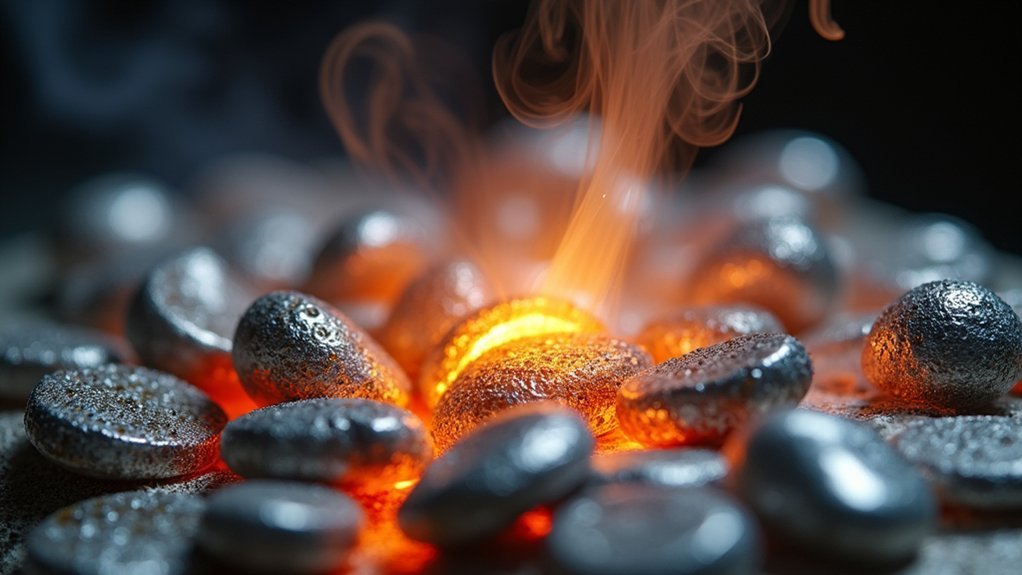
Leave a Reply